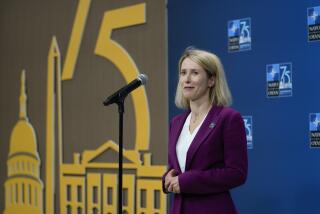ESTONIA : Old Is New Again in Backlash to Reform
- Share via
TALLINN, Estonia — Most of the nation’s top rock musicians are his staunch supporters, so, if nothing else, the youngest and most successful market reformer in the former Soviet Union could at least put together a band.
He’ll probably have the spare time too.
The 34-year-old Mart Laar and Estonia’s other young radicals are expected to get trounced in elections Sunday, ending the long and, some say, wildly successful reign of 20- and 30-somethings in this small Baltic nation.
In an election that shapes up as a clash of generations, Europe’s youngest leaders are expected to be defeated by a mixture of former Communists and onetime factory directors old enough to be the incumbents’ grandfathers.
Admirers of Estonia’s youthful reformers credit them with pulling the economy from the wreckage of communism with tightfisted monetary policies and no-nonsense free-market schemes that would make even hard-core capitalists blush.
After coming to power in 1992, the young reformers cut subsidies, slashed import tariffs and kept across-the-board social spending to a bare minimum.
In the face of plummeting popularity and opposition charges of financial mismanagement, the blond, blue-eyed Laar was forced to step down as prime minister several months ago, although most of his handpicked ministers have stayed on.
The former prime minister has become a lightning rod for the disgruntled majority, who say reforms have brought them nothing but poverty.
Critics blast Laar and his colleagues, many of them fraternity brothers, for being too callous and cocky and for wholly disregarding the plight of the poor and the elderly.
Opinion polls reflect the discontent. Support for Laar’s National Coalition Party, which dominates the current government, hovers at about 5%.
*
Asked about the hardships blamed on him, Laar smiles boyishly and insists that only painful, politically unpopular reforms could have rescued Estonia’s shattered post-Soviet economy.
“Yeah, it was a dirty job,” Laar said in an interview outside his campaign headquarters. “But somebody had to do it, and I did it. And Estonia is totally transformed as a result.”
Among the achievements: a balanced budget, 5% annual growth, and an influx of an impressive $337 million in foreign investment, the third-highest per capita rate in Eastern Europe.
While the International Monetary Fund and the World Bank have been impressed, there is little talk about economic miracles at Tallinn’s Mustamae post office, where elderly Estonians collect their meager monthly pensions.
Gray-haired grandmothers and bent old men grumble about trying to make ends meet on as little as $50 a month in a country where many prices long ago reached Western levels. One 64-year-old pensioner said he was especially irked by the sense that the elderly were being systematically shut out of the post-Soviet economy.
He pointed to classified ads seeking workers in the booming private sector. Many include one prerequisite: age 35 and younger only.
“The young ones rule, and they’re the ones who live well,” he complained. “It’s better if the old just die fast.”
The 330,000 pensioners, the nation’s most powerful voting bloc, are expected to lash back Sunday, casting votes for more hesitant reformers who have said they will raise pensions.
The main beneficiary of discontent among the elderly will be the alliance that includes the Estonian Coalition Party and the Rural Union, which unites center-leftists and farm activists.
Polls indicate that the alliance will win 40 seats in the 101-seat Parliament, more than enough to lead the way in forming a new government.
More to Read
Sign up for Essential California
The most important California stories and recommendations in your inbox every morning.
You may occasionally receive promotional content from the Los Angeles Times.












